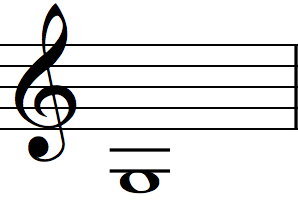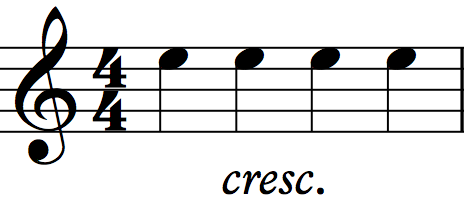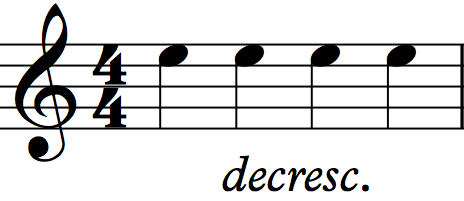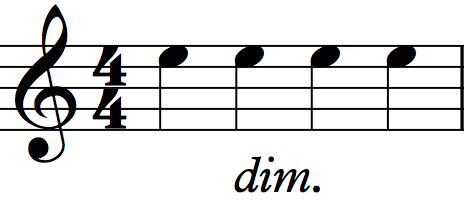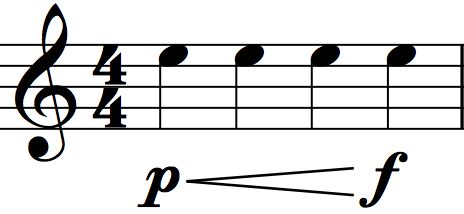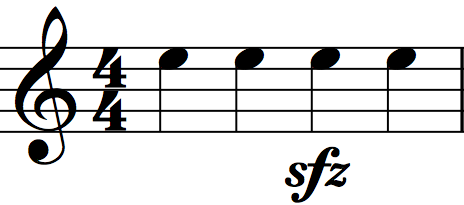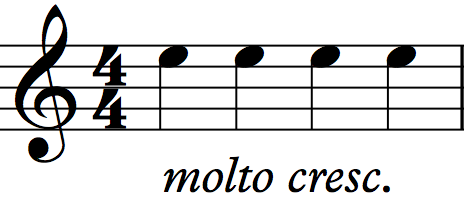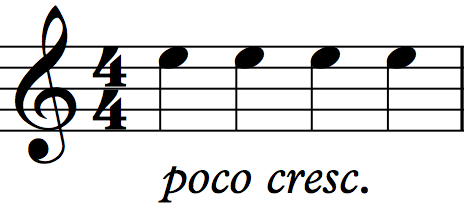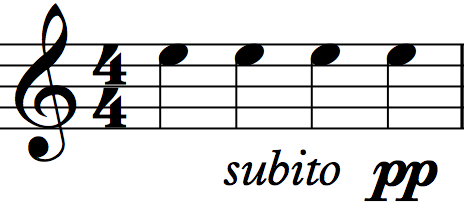8 Notes on the Sixth String & Dynamics
INTRODUCTION
In this unit you will learn two fretted notes on the sixth string and dynamics.
NOTATIONS
Notes
The Note ‘F’

‘F’ is on the third leger line below the staff. To play ‘F’, fret the first fret on the sixth string.
The Note ‘G’
‘G’ is underneath the second leger line below the staff. To play ‘G’, fret the third fret on the sixth string.
Dynamics
The word dynamic refers to variations in loudness. Since music notation developed over a vast period of time and place (and continues to develop) there are a few ways to notate dynamic. The dynamics in this section relate to the Italian words piano (soft), forte (strong) and mezzo (half). The list below includes the symbol, its Italian name and its musical direction. It is organized from the softest to the loudest dynamic.
| Symbol | Italian name | Musical direction |
| ppp | pianississimo | extremely soft |
| pp | pianissimo | very soft |
| p | piano | soft |
| mp | mezzopiano | moderately soft |
| mf | mezzoforte | moderately loud |
| f | forte | loud |
| ff | fortissimo | very loud |
| fff |
fortississimo | extremely loud |
Gradual Dynamic Changes
Crescendo
The crescendo, directs you to grow louder. The word means “increasing” in Italian.
Decrescendo
The decrescendo directs you to grow softer. The word means “decreasing” in Italian.
Diminuendo
The diminuendo directs you to grow softer. The word means “diminishing” in Italian.
Hairpin Crescendo
Hairpins direct you to either grow louder or softer over time. They are usually placed under the staff and relate to the notation directly above. A hairpin crescendo that widens from left to right directs you to grow louder.
Hairpin Decrescendo
A hairpin decrescendo that narrows from left to right directs you to grow softer.
Sudden Dynamic Change
Sforzando
The sforzando involves a sudden and loud accent. It is short for subito forzando, which means “suddenly, with force” in Italian.
Dynamic Modifiers
Molto
The molto is a modifier that is usually paired with another dynamic (as in the example above). The word means “much” in Italian. It directs you to enact a more dramatic change of dynamic.
Poco
The poco is a modifier that is usually paired with another dynamic (as in the example above). The word means “little” in Italian. It directs you to enact a more subtle change of dynamic.
Subito
The subito is a modifier that is usually paired with another dynamic (as in the example above). The word means “suddenly” in Italian. It directs you to instantly change dynamic.
Let’s Play |
Sight-Reading Tip
Dynamic changes force us to listen to the acoustic space, other players and our own playing. Attentive listening can create relaxation and exhilaration at the same time. Become acquainted with the diverse effects of careful listening as you sight-read.
Checklist for Sight-Reading
- Count the beats out loud (including the &).
- Keep going (even if you make a mistake).
- Maintain your best playing posture.
- Look at the score, not your hands.
- Play with the feel of the meter.
- Play patterns instead of individual notes (AKA chunk).
- Cultivate a calm demeanor.
- Have fun!
Let’s Play Rhythms |
Attitude Tip
The most important thing I look for in a musician is whether he knows how to listen. –Duke Ellington
Exercise 8.1: Score
Exercise 8.1: Audio
Exercise 8.2: Score
Exercise 8.2: Audio
Exercise 8.3: Score
Exercise 8.3: Audio
Let’s Play Patterns |
Attitude Tip
Time passes. Listen. Time passes. Come closer now.[1] –Dylan Thomas from Under Milk Wood
Exercise 8.4: Score
Exercise 8.4: Audio
Let’s Play Duets |
Attitude Tip
In music, silence is more important than sound. –Miles Davis
Exercise 8.5: Score
Exercise 8.5: Audio
from Sonata in C Major by Domenico Scarlatti: Score
from Sonata in C Major: Audio
Congratulations!
You have completed this unit! If you kept up with the beat and accurately played approximately 70% of the pitches and rhythms, you are ready for the next unit. Feel free to repeat the exercises. However, do not play them so often that you memorize them. Once you memorize the notation, you are no longer developing the skill of sight-reading.
- Dylan Thomas, Under Milk Wood (New York: New Directions, 1954), 3. Congratulations!You have completed this unit! If you kept up with the beat and accurately played 60-70% of the pitches and rhythms, you are ready for the next unit. Feel free to repeat the exercises. However, do not play them so often that you memorize them. Once you memorize the notation, you are no longer developing the skill of sight-reading. ↵

